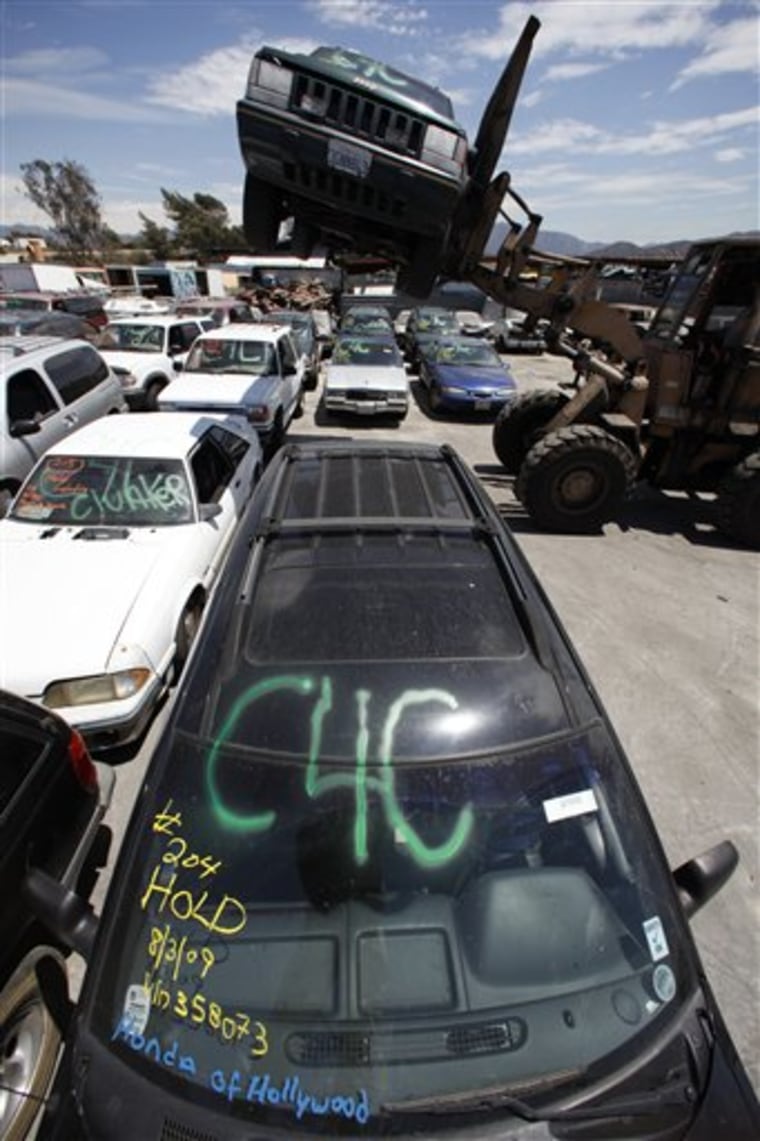The popular "cash-for-clunkers" program may be a well-timed shot of adrenaline for the economy, but it's not a prescription for a lasting recovery.
The federal rebates of up to $4,500 to drivers who trade in a gas guzzler for a more fuel-efficient vehicle are steering cash to car dealers, giving a boost to troubled automakers and generating much-needed sales taxes for cities.
All this will help the economy grow faster in the second half of the year than previously forecast. Yet the rebates will also steal economic growth from the future: They make car sales happen now that would have been made later anyway.
"Cash for clunkers," soon to be a $3 billion program after an expected extension from Congress, comes at a critical time for the economy. Recent data suggest the country is finally emerging from the worst recession since World War II.
And clunker cash delivers more than just an isolated jolt to the auto industry. More business for auto dealers, manufacturers and parts suppliers could mean fewer layoffs or even some hiring, meaning more people are spending money throughout the economy.
But the rapid success of "cash for clunkers" — it's credited with making July the best month for car sales in nearly a year — does not mean the program should be expanded to, say, $10 billion.
There are only so many people looking to trade in pickups for hybrid sedans. And there are only so many people who can afford to.
Even if clunker cash helps the economy expand at a 4 percent annual rate from July through December — the high end of the most optimistic forecasts — underlying problems will make the pace hard to sustain.
Consumers, the lifeblood of the economy, lack confidence. Their take-home pay is flat or falling. Some of them are expanding their debt with bigger car loans. And the outlook for jobs remains lousy.
The "cash-for-clunkers" program has provided a burst of sales that will give auto makers and their suppliers a need to replenish thin inventories. That's good news for people who work at dealerships, auto plans and parts factories.
But the help is likely to be short-lived.
Mark Zandi, chief economist at Moody's Economy.com, is among those predicting the "cash-for-clunkers" program will help boost consumer spending in the second half of this year. But he predicts spending will flatten out as the benefit fades.
As a result, Zandi nudged his projection for economic growth in the second half of this year slightly higher, and lowered his estimate for growth in the first half of next year.
Some analysts worry that people who used clunker cash to buy a new car or truck may cut back on other things, like clothes and home furnishings. And history suggests auto promotions gin up sales only temporarily.
In 2005, for example, General Motors offered a promotion giving shoppers the same discount employees got. That powered sales to record highs. By October, sales were flagging again.
"Once these clunker rebates expire, it is over," said economist Richard Yamarone of Argus Research. "Consumers are not going to keep buying cars. It is a temporary one-time gimmick, not a long-lasting tonic for the recovery."
Clunker cash no doubt motivated people already thinking about buying a new car to lock in the deal. The government estimates 300,000 Americans have taken advantage of the program.
It's impossible to say how many cars wouldn't have been sold without the incentive. But even if sales improve for the rest of this year, auto companies — and companies in general — are unlikely to start hiring again with gusto.
The unemployment rate is already at a 26-year high of 9.5 percent, and economists expect it to top 10 percent by the end of the year — even if the economy starts growing again.
Rising unemployment and stagnant or shrinking wages mean Americans will stay fairly cautious about spending in the months ahead. They are "many quarters away from a shop-until-you-drop phase," predicted Paul Kasriel, economist at Northern Trust Global Economic Research.
Analysts predict the economy will start to grow again this quarter, mostly because of businesses restocking inventories. Last quarter, businesses reduced them at a record pace, setting the stage for a pickup in production.
In the second half of this year, experts figure the economy will grow at roughly a 2 percent to 4 percent annual rate. They estimate the $3 billion from "cash for clunkers" could provide a lift of 0.25 to 1 percentage point.
For a sustained recovery to take hold, businesses and people must spend and invest at normal levels again, and banks have to lend more freely. The housing market must get back on its feet. And unemployment needs to ease.
Economists are counting on the government's $787 billion stimulus package to help. One piece of it, spending on big public works projects like road repairs, should help spur job creation next year.
"At times like these, you have to have all the different types of oars pulling in the same direction," said Ken Mayland, president of ClearView Economics. "You can't just have one."
